|
|
Technical Innovations
At first ukiyo-e weren't prints
but paintings made with sumi(black ink); later on, color
was added, and as the number of colors increased and the paintings became
more complicated, Making woodblock prints was a three-stage process: (1) painting a design with ink, (2) carving the design onto wooden blocks, and (3) applying colored ink to the blocks and pressing sheets of paper on them to print the design. There were specialists for each of these stages, and the entire process took a lot of work, but once the blocks were completed, it became much easier than before to make reproductions of the same design.
Ukiyo-e Genres As ukiyo-e developed
into popular art, subjects having to do with entertainment came to be
taken up. Yakusha-e were portraits of kabuki actors in
popular roles; they were sort of like the posters and photographs of
movie stars that you can get today. Bijin-ga illustrated
beautiful women of Edo (present-day Tokyo). Influence on Western Art At around the end of the nineteenth
century, European painters came across ukiyo-e prints
that were being used as wrapping paper. They were struck very strongly
by the expressive curves, bold use of colors, and liberal designs of
ukiyo-e.
|
|
Photos (from top): Mikaeri Bijin (A Beauty Looking over Her Shoulder) by Hishikawa Moronobu; Ichikawa Monnosuke (The Actor Ichikawa Monnosuke) by Torii Kiyonobu; Tokaido Gojusantsugi: Yokkaichi (Fifty-Three Stations of the Tokaido: Yokkaichi) by Utagawa Hiroshige; Sawamura Sojuro (The Actor Sawamura Sojuro) by Utagawa Toyokuni; Furyu Rokkasen: Sojo Henjo (Six Famous Poets: The Priest Henjo) by Suzuki Harunobu. (Courtesy of the Tokyo National Museum) |
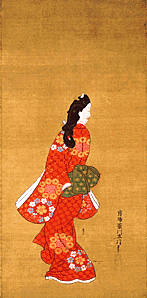 The word ukiyo refers to the world
of common people and e means "picture." Thus when ukiyo-e first
emerged in the late sixteenth century, it usually depicted everyday
life in the city of Kyoto. It wasn't until the eighteenth century that
ukiyo-e became a popular art form, though, thanks partly
to advances in woodblock printing techniques. Also, familiar subjects
like kabuki actors and beautiful women came to be depicted around this
time, and books carrying illustrations by young ukiyo-e artists
were widely circulated. These factors helped ukiyo-e become
a part of Japan's popular culture.
The word ukiyo refers to the world
of common people and e means "picture." Thus when ukiyo-e first
emerged in the late sixteenth century, it usually depicted everyday
life in the city of Kyoto. It wasn't until the eighteenth century that
ukiyo-e became a popular art form, though, thanks partly
to advances in woodblock printing techniques. Also, familiar subjects
like kabuki actors and beautiful women came to be depicted around this
time, and books carrying illustrations by young ukiyo-e artists
were widely circulated. These factors helped ukiyo-e become
a part of Japan's popular culture.
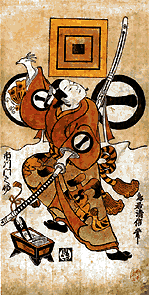 the woodblock printing technique was developed to mass-produce prints
of the same design. Only a few colors were used in the early prints,
but as the technique improved, ukiyo-e became more colorful
and refined.
the woodblock printing technique was developed to mass-produce prints
of the same design. Only a few colors were used in the early prints,
but as the technique improved, ukiyo-e became more colorful
and refined.
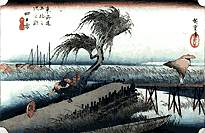 The
prints mass-produced in this way were circulated widely among the public,
and ukiyo-e developed into a popular art form.
The
prints mass-produced in this way were circulated widely among the public,
and ukiyo-e developed into a popular art form. 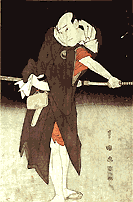 You can think of them as images of the ideal urban woman. Landscapes
didn't become the subjects of ukiyo-e until later,
when people became better off and could go on trips for leisure. Landscape
prints were used as today's equivalent of postcards.
You can think of them as images of the ideal urban woman. Landscapes
didn't become the subjects of ukiyo-e until later,
when people became better off and could go on trips for leisure. Landscape
prints were used as today's equivalent of postcards.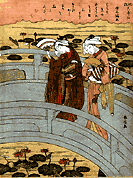 Until
then, European and U.S. artists had never come across the sorts of techniques
that ukiyo-e artists used. Ukiyo-e thus
had a great influence on such Impressionist painters as Vincent van
Gogh and Claude Monet.
Until
then, European and U.S. artists had never come across the sorts of techniques
that ukiyo-e artists used. Ukiyo-e thus
had a great influence on such Impressionist painters as Vincent van
Gogh and Claude Monet.